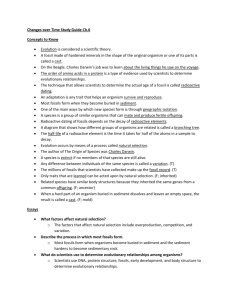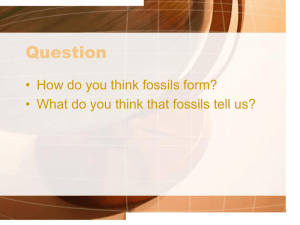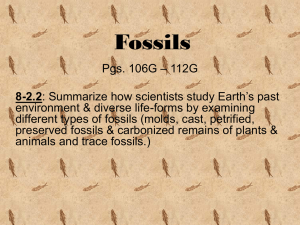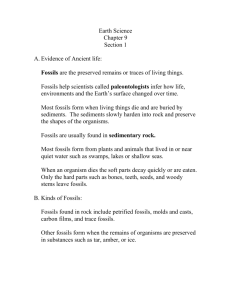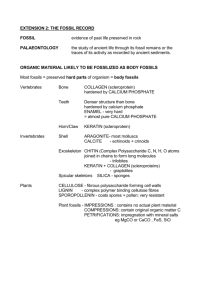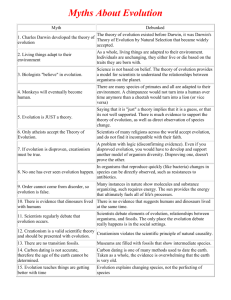Paleontology Final Paper
advertisement
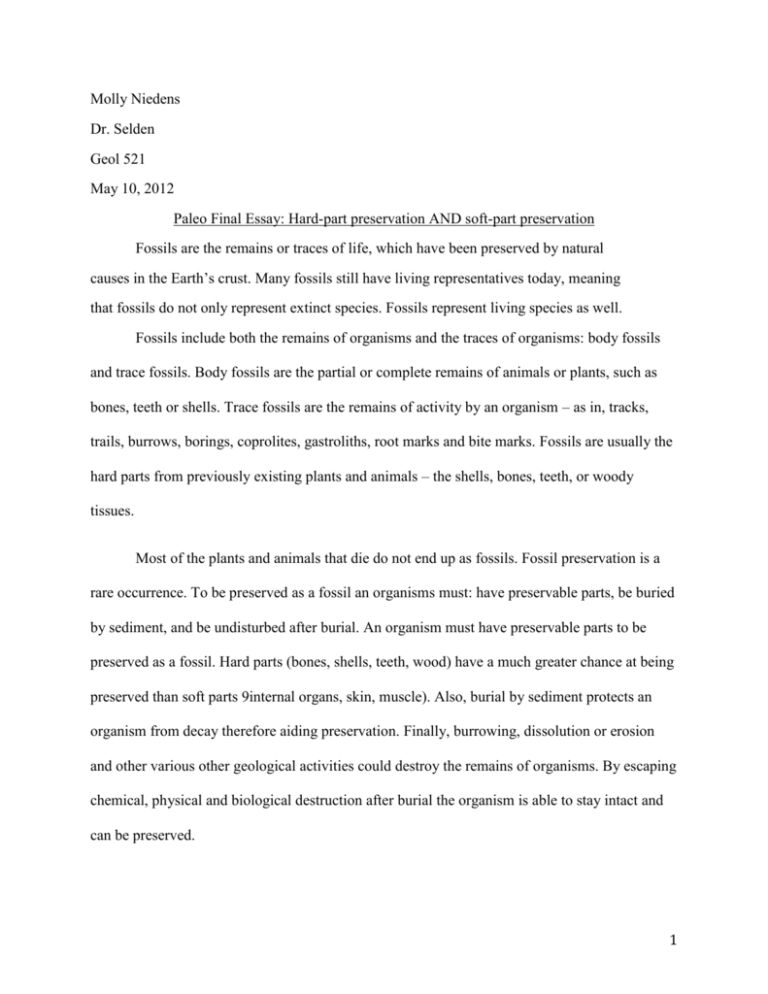
Molly Niedens Dr. Selden Geol 521 May 10, 2012 Paleo Final Essay: Hard-part preservation AND soft-part preservation Fossils are the remains or traces of life, which have been preserved by natural causes in the Earth’s crust. Many fossils still have living representatives today, meaning that fossils do not only represent extinct species. Fossils represent living species as well. Fossils include both the remains of organisms and the traces of organisms: body fossils and trace fossils. Body fossils are the partial or complete remains of animals or plants, such as bones, teeth or shells. Trace fossils are the remains of activity by an organism – as in, tracks, trails, burrows, borings, coprolites, gastroliths, root marks and bite marks. Fossils are usually the hard parts from previously existing plants and animals – the shells, bones, teeth, or woody tissues. Most of the plants and animals that die do not end up as fossils. Fossil preservation is a rare occurrence. To be preserved as a fossil an organisms must: have preservable parts, be buried by sediment, and be undisturbed after burial. An organism must have preservable parts to be preserved as a fossil. Hard parts (bones, shells, teeth, wood) have a much greater chance at being preserved than soft parts 9internal organs, skin, muscle). Also, burial by sediment protects an organism from decay therefore aiding preservation. Finally, burrowing, dissolution or erosion and other various other geological activities could destroy the remains of organisms. By escaping chemical, physical and biological destruction after burial the organism is able to stay intact and can be preserved. 1 Not all organisms have an equal chance to be preserved. Organisms must live in a suitable environment for preservation. Generally, marine and shoreline environments are more favorable for fossil preservation than are continental environments since the rate of sediment deposition tends to be higher. When a plant or animal does become fossilized, there are several stages to the process that get the dead organism to being a fossilized organism: the soft tissues of the plant or animal decay, the transport or breakage of hard parts, and then, there is the burial and/or modification of the hard tissues. In rare cases, soft parts are preserved. The preservation of soft-bodied organisms and soft pars is called exceptional preservation. The remains of organisms may be fossilized in a variety of ways and some fossils are preserved in more than one way. Some of the many types of fossil preservation include: the preservation of unaltered hard parts, chemical alteration of hard parts, imprints of hard parts in the sediment, trace fossils, and exceptional preservation. The preservation of unaltered hard parts is referred to as original material. This includes shells, bones or teeth that may be preserved unaltered. There are many different compositions of original material that may get preserved. These many different compositions include: phosphate, silica, calcite, aragonite, and organic hard parts. Bones and teeth of vertebrates, the outer covering of trilobites, and the shiny scales of fossil fish are composed of phosphate, usually in the form of apatite; hard parts made of silica are that such as skeletons of certain protists (Radiolarians, Diatoms); and some types of sponges and hard parts made of calcite, such as with echinoderms and in certain protists, all may get preserved unaltered. Aragonite makes up the shells of clams, snails, and certain corals and may 2 be preserved unaltered in recent fossil deposits but they are generally not found unaltered in older deposits. This is due to the fact aragonite is more soluble than calcite; therefore, the aragonite composing the fossils recrystallizes to calcite over long periods of time. Organic hard parts are made of more resistant like keratin, cellulose, chitin, collagen or certain proteins that are unique to spone skeletons. These organic hard parts are present in many arthropods (chitinous skeletons – trilobites, insects, etc.) and plant hard parts, such as wood (cellulose). The hard parts of fossils can be chemically altered by the addition, removal, or the rearrangement of chemical properties. Permineralization is the near-complete replacement of the tissues of an organism by mineral material. The pores, or tiny holes, in wood, bone, or shell are filled by the deposition of minerals from solution. This makes the permineralized fossil much heavier then the original material due to the added mineral matter. A common example of permineralization includes petrified wood. As previously mentioned, many modern shells are made of aragonite. We do nto find many aragonite shells in older deposits because of recrystallization. Aragonite, a form of calcium carbonate, is only stable for a relatively short period of time however. Over long periods of time the aragonite will eventually alter or recrystallize to calcite with is a more stable form of calcium carbonate. Replacement is the mole-by-molecule substitution of another mineral of different composition for the original material. The fine details in shell structures are generally preserved through this chemical alteration. This includes the shell designs on ammonite shells. Silica and 3 Pyrite are minerals that commonly replace hard parts. Carbonization is the chemical process that preserves plants or animals as a thin carbon film, usually in shale or other fine-grained sediment. Carbonization helps preserve the finer details of organisms. Plant fossils are usually preserved this way – through carbonization in shale. Soft-bodied animals could also be preserved in black shales as carbonaceous films. Imprints are one of the more common preservation types. Imprints occur when hard parts lay in sediment, making an imprint of their shell, and then the hard parts are destroyed by decay or chemical dissolution after burial, leaving a record of their former presence in the sediment. Imprints can happen in the form of a mold or a cast. A mold, or an impression as it is also called, is the imprint of an organism (or part of an organism) in the sediment. External molds are imprints of the outside of a shell in a rock. This will be the opposite shape of the original shell/material (generally). Internal molds are the imprint of the inside of the shell in a rock. Internal molds are produced when a shell is filled in with sediment, which becomes cemented, and then the shell is dissolved away. The other type of imprint, casts, can be produced if a mold is filled with sediment or mineral matter. Casts are relatively uncommon compared to molds. A cast acts as a replica of the original. As declared earlier, exceptional preservation is rare. There are two main methods where soft parts can be preserved unaltered. These methods are freezing and desiccation. Desiccation is the drying or mummification of an organism. Examples of preserved organisms due to freezing include the frozen Siberian mammoths and sloths. Preservation in the case of freezing is dependent on climatic conditions and such fossils are unlikely to survive any significant amount 4 of geological time since climate is ever changing. Soft parts can be preserved if the organisms becomes trapped in sap, or pine resin, with later alters to amber. There are many more ways to preserve hard-parts than soft-parts. Fossils are important because they tell us about organisms that lived on the Earth many years ago. By studying fossils we can learn not only of the creatures and plants in the past, but we learn how they moved, what they ate, how they grew, how they interacted amongst themselves, and many other aspects of their behavior. Fossils also help us understand past climates including climactic changes from ice ages to warming periods. By studying these climatic changes we know more the fluctuations in abundance or extinction of certain species. There are many reasons why fossils are important and knowing the differences between hard-part preservation and soft-part preservation only helps in understanding the behaviors of organisms and the processes that brought them to fossilization. 5


